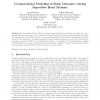Free Online Productivity Tools
i2Speak
i2Symbol
i2OCR
iTex2Img
iWeb2Print
iWeb2Shot
i2Type
iPdf2Split
iPdf2Merge
i2Bopomofo
i2Arabic
i2Style
i2Image
i2PDF
iLatex2Rtf
Sci2ools
MSV
2007
2007
Computational Modeling of Brain Dynamics during Repetitive Head Motions
Abstract We numerically model the effects of repetitive human head motions in traumatic scenarios that are associated with severe brain injuries. Our results are based on the linear Kelvin-Voigt brain injury model, which treats the brain matter as a viscoelastic solid, and on our nonlinear generalization of that model, which emulates the gel-like character of the brain tissue. To properly compare the various traumatic scenarios, we use the BIC scale, which we developed to generalize the HIC scale to arbitrary head motions. Our simulations of the brain dynamics in sagittal and horizontal 2D cross-sections of the skull interior indicate that a repetitive reversal of traumatic head rotations can increase the severity/likelihood of brain injuries due to resonance effects.
| Added | 30 Oct 2010 |
| Updated | 30 Oct 2010 |
| Type | Conference |
| Year | 2007 |
| Where | MSV |
| Authors | Igor Szczyrba, Martin Burtscher, Rafal Szczyrba |
Comments (0)

